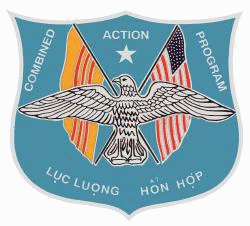
Introduction
US Marines
Combined Action Platoons
Vietnam, 1965-1971
 |
Introduction |
In his memoir of the Vietnam War, General Lewis Walt, commander of U.S. Marine forces in Vietnam from May, 1965, to May, 1967, summed up what he believed to be the key to how to fight the war.
Beyond the three marine enclaves at Da Nang, Chu Lai, and Phu Bai in I Corps lay myriad villages containing over 2 million people. Most of these villages had long been under tight Vietcong control. General Walt proposed to regain them for the GVN by using The Velvet Glove, a combination of friendly aid and physical security. Officially, the Marine Corps called its pacification program civic action.
The first marine civic action efforts were spontaneous, informal projects begun by individual marines. In April, 1965, 1st. Lieutenant William Francis, the civil affairs officer for the 3d Marine Division, established a medical dispensary in a shantytown called Dogpatch at the edge of the Da Nang air base. Lt. Francis begged and borrowed medicines to equip the dispensary and assigned a Vietnamese nurse, a U.S. Navy hospital corpsman, and a navy lab technician to run it. The Vietnamese welcomed the project, but by the summer of 1965 Francis was frustrated. The marines, he felt, "were just sort of groping and feeling with inadequate supplies and personnel."
Lt. Francis's project attracted the attention of his superiors, however, and General Walt authorized his staff to expand it. By the fall, marines established medical civic action projects, or MEDCAPs. MEDCAP units, made up of several navy corpsmen escorted by an armed marine squad, conducted regular sick calls in villages. While providing treatment for illnesses that ranged from malnutrition to parasite infections, the marines trained Vietnamese volunteers in rudimentary health care practices. Navy corpsmen, like Josiah "Doc" Lucier of Birmingham, Alabama, braved booby-trapped trails to give injections, distribute drugs, and administer first aid in out-of-the-way hamlets. "Until we start treating these people like human beings, they aren't going to want to help us," Lucier said.
Some marines scoffed at civic action efforts, calling them "candy and pill patrols" that did little good. Besides, they were dangerous. "We try to help these goddamn people," one marine private explained, "and you know what they do? They send in their kids to steal our grenades and ammunition and use them to kill us. The hell with them!" General Walt replied to such criticisms by patiently explaining that
The most ambitious Marine pacification program took root in the summer of 1965. Captain John T. Mullin, Jr., the civil affairs officer for the 3d Battalion, 4th Marines, based at Phu Bai, saw an under-used resource in the marines' own backyard. Mullin thought that the Vietnamese Popular Forces soldiers, a poorly trained, ill-equipped local militia charged with defending villages, might be upgraded into an aggressive, effective fighting force if U.S. Marines took them under their wings. Mullin's idea impressed his commanding officer, Lieutenant Colonel William "Woody" Taylor. In July Col. Taylor ordered his executive officer, Major Cullen C. Zimmerman, to draw up a plan for incorporating marines into PF units.
The plan called for combining a squad of fourteen marines plus one navy medical corpsman with three squads of PF soldiers, making a group of some fifty men in all. Called Combined Action Platoons (CAPS), these new units attracted a special breed of marine volunteer--highly motivated, idealistic, and sympathetic to the Vietnamese people. Lt. Richard Cavagnol, an artillery forward observer for the 3d Marine Division who witnessed the formation of CAPs, said all these men "really believed they could help the Vietnamese people, and by doing so, help win the war."
On the surface, the PFs were unlikely candidates to turn the war around. Some had been declared ineligible for service in regular ARVN units, and all lay at the bottom of the Vietnamese military structure. Pay was as low as 1,200 piasters per month, less than 10 dollars. Their weapons were limited to grenades and M1 carbines. Few were issued uniforms or other equipment, and many received no training. As a result, most PFs rarely defended their makeshift compounds and offered little security to villagers against VC attacks. Some made tacit "live and let live" agreements with the Vietcong or hid in towns, absent without leave. But General Walt believed the PF soldier was a potentially vital fighting force. "He was defending his own home, family, and neighbors. He knew each paddy, field, trail, bush, or bamboo clump, each family shelter, tunnel, and buried rice urn."
Hoping to impress the PF soldiers by example, the marines showed them various techniques. Each marine kept a small notebook in which he recorded the daily activities of villagers in order to spot suspicious behavior. This intelligence-gathering practice aroused curiosity among PF soldiers. Marines patrolled after dark, took the point positions, and fired aggressively on the enemy when they found him, hoping the PFs would do the same. Some PFs caught on fast, responding with cunning and courage to the marine's examples. "They will fight if they know the system is competent and cares," one marine said. A CAP-trained PF soldier was the first Vietnamese decorated by the United States with a Bronze Star for heroism.